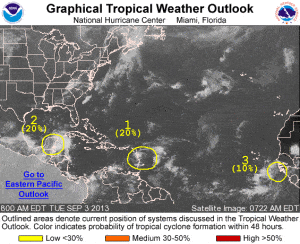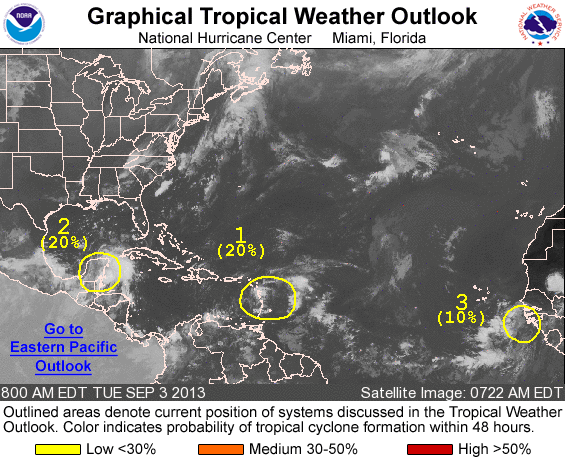Three potential tropical systems stretch across the Atlantic from Mexico’s Yucatan Peninsula to Africa’s west coast, though none is expected to become a major threat this week, forecasters said.
The westernmost of the three, over the Yucatan, has a 20 percent chance of becoming a tropical system in the next two days, according to the U.S. National Hurricane Center in Miami. The second, over Dominica in the Lesser Antilles, is given 20 percent odds for growth in the next 48 hours, while the one off Africa has a 10 percent chance.

“None of them look too imminent for development at this point,” Matt Rogers, president of Commodity Weather Group LLC in Bethesda, Maryland, said in an e-mail interview.
Storms are tracked by energy and commodity markets because they can disrupt supply and demand of petroleum products, natural gas and crops. The Gulf of Mexico is home to about 6 percent of U.S. natural gas output, 23 percent of oil production and more than 45 percent of petroleum refining capacity, according to the U.S. Energy Department.
Florida, which is struck more often than any U.S. state, is the second-largest producer of oranges behind Brazil.
The disturbance over the Yucatan may have time to develop once it gets into the Bay of Campeche, said MDA Weather Services in Gaithersburg, Maryland. It isn’t likely to become a problem for the main U.S. Gulf energy production area, MDA said.
Antilles Outlook
The Lesser Antilles system is expected to bring downpours across the islands, as well as Puerto Rico, as it drifts northwest through the week, according to AccuWeather Inc. in State College, Pennsylvania.
The storm area is expected to then swing into the western Atlantic and out to sea, away from land, MDA predicts.
Rogers said he doubts there will be much chance of a large tropical system developing in the next week or so.
“Today is the 95th day of the Atlantic hurricane season with still zero hurricanes so far,” Rogers said in his daily forecast. “The models are showing a few windows with tropical development potential, but the earliest risk to the Gulf looks to be toward late next week into the middle part of September.”
The most active part of the Atlantic season runs from Aug. 20 to about the first week of October. The statistical peak occurs on Sept. 10, according to the hurricane center. Six tropical storms, with winds of at least 39 miles (63 kilometers) per hour, have formed in the Atlantic so far this season. None of them became hurricanes.
(Editors: Charlotte Porter, Margot Habiby)
Was this article valuable?
Here are more articles you may enjoy.


 Tricolor Trustee Plans to Sue Founder for Auto Dealer’s Collapse
Tricolor Trustee Plans to Sue Founder for Auto Dealer’s Collapse  Thailand’s Record Floods Paralyze Key Hubs for Tech and Car Parts
Thailand’s Record Floods Paralyze Key Hubs for Tech and Car Parts  State Farm Sued Over Policies Backed by Distressed Insurer PHL
State Farm Sued Over Policies Backed by Distressed Insurer PHL  Abbott Presses Congress for Shield Over Preemie Baby Formula Litigation That Could Cost It Billions
Abbott Presses Congress for Shield Over Preemie Baby Formula Litigation That Could Cost It Billions 